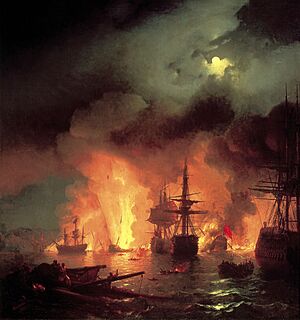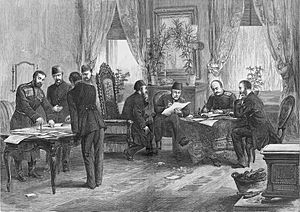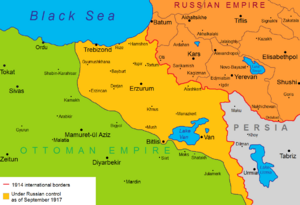History of the Russo-Turkish wars facts for kids
The Russo-Turkish Wars were a long series of twelve major wars fought between the Russian Empire and the Ottoman Empire. These conflicts happened over several centuries, from the 16th to the 20th century. They are known as one of the longest series of military fights in European history. Most of these wars ended badly for the Ottoman Empire. For Russia, these wars showed its rise as a strong European power, especially after Peter the Great modernized the country in the early 1700s.
Contents
History of the Wars
Early Conflicts (1568–1739)
Before Peter the Great
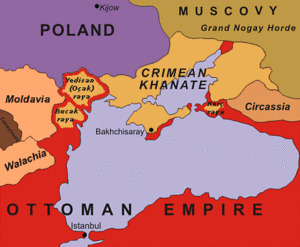
The first war between Russia and Turkey happened after the Russian ruler, Ivan the Terrible, took over the cities of Kazan and Astrakhan. In 1569, the Ottoman Sultan Selim II tried to push the Russians out of the lower Volga River. He sent an army to Astrakhan, but this plan failed badly. The Ottoman army was almost completely lost in the steppes (flat grasslands), and their ships were destroyed in the Sea of Azov. The peace treaty that followed confirmed Russia's control over the Volga region. However, it also gave the Ottoman Empire some trade benefits. The Crimean Khanate, which was like a smaller state under Ottoman control, kept attacking Russia. But they were defeated in the Battle of Molodi in 1572.
About 100 years later, another conflict started over control of Ukraine. Russia had taken control of eastern Ukraine after a war with Poland. The Ottoman Empire then took over western Ukraine, supported by their local leader, Petro Doroshenko. Many Ukrainian Cossacks (a group of warriors) didn't like Doroshenko's pro-Ottoman policy. So, they chose Ivan Samoilovich as their leader in 1674. In 1676, Russian troops captured the city of Chigirin and sent Doroshenko away. The Ottoman army tried to get Chigirin back in 1677 but failed. In 1678, they finally took Chigirin after a tough fight. But this stopped the Ottoman Empire from expanding further northeast. From 1679 to 1680, the Russians fought off attacks from the Crimean Tatars. In 1681, they signed the Treaty of Bakhchisarai, which set the border between Russia and Turkey along the Dnieper River.
Peter the Great's Era
Russia joined the European Holy League (which included Austria, Poland, and Venice) in 1686. During this time, the Russian army launched campaigns into Crimea in 1687 and 1689. They also attacked Azov in 1695–96.
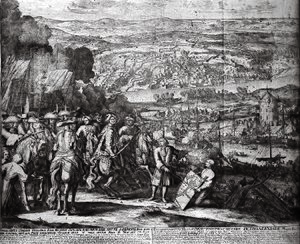
Because Russia was getting ready for a war with Sweden, and other countries had made peace with Turkey, Russia signed the Treaty of Constantinople with the Ottoman Empire in 1700. This treaty allowed Russia to take over Azov and gain access to the Sea of Azov.
In 1709, Russia defeated Sweden and its Ukrainian allies in the Battle of Poltava. After this, the Swedish king, Charles XII of Sweden, convinced the Ottoman Sultan Ahmed III to declare war on Russia in November 1710. This war, known as the Prut campaign, went very badly for Russia. The Russian army, led by Peter the Great himself, was surrounded by a larger Turkish-Tatar army. Russia was forced to agree to a harsh peace deal, giving Azov back to the Ottoman Empire.
By the late 1600s, the Iranian Safavid dynasty, a long-time rival of Turkey, was getting weaker. Russia and the Ottoman Empire took advantage of this. They conquered large parts of Iran's territory. Russia, under Peter I, took areas in modern-day Dagestan, Azerbaijan, and northern Iran in the Russo-Persian War (1722–1723). The Ottomans took land to the west, including parts of modern Armenia and eastern Anatolia. These gains were confirmed in the Treaty of Constantinople (1724). For a few years, Russia and the Ottoman Empire shared a long border in the Caucasus region, which led to more disagreements.
Russia improved its position by signing treaties with Persia in 1732 and 1735. These treaties returned all Iranian lands Russia had gained since 1722. This helped Russia avoid war with Persia's new leader, Nader Shah. These treaties also created an alliance between Russia and Iran against Turkey, as Persia was already fighting the Ottoman Empire. At the same time, Russia supported Augustus III of Poland becoming the Polish king during the War of the Polish Succession (1733–35). Austria had been Russia's ally since 1726.

Russia entered another war with the Ottoman Empire in 1736. This was caused by Crimean Tatars raiding Ukraine and a military campaign by the Crimean khan in the Caucasus. In May 1736, the Russian army invaded Crimea and burned its capital, Bakhchysarai. In June, the Russian Don army captured Azov. In July 1737, the Russian army, led by Burkhard Christoph von Münnich, stormed the Ottoman fortress of Ochakov. Another Russian army marched into Crimea, defeating the Crimean khan's forces and capturing Karasubazar. However, these Russian forces had to leave Crimea due to a lack of supplies.
Austria joined the war against Turkey in July 1737 but was defeated several times. In August, Russia, Austria, and Turkey tried to negotiate peace, but it didn't work. There were no major battles in 1738. The Russian army had to leave Ochakov and Kinburn because of a plague outbreak. In 1739, the Russian army crossed the Dnieper River, defeated the Ottoman Empire at Stavuchany, and took the fortresses of Khotin and Iaşi. However, Austria was defeated again and signed a separate peace treaty in August. This, along with the threat of a Swedish invasion, forced Russia to sign the Treaty of Belgrade with Turkey on September 18, ending the war.
Ottoman Empire's Decline (1768–1878)
Catherine the Great's Era
After a small incident at the border, Sultan Mustafa III declared war on Russia on September 25, 1768. The Turks allied with Polish rebels, while Russia was supported by Great Britain, which sent naval advisors.
The Polish rebels were defeated by Alexander Suvorov. He then moved to the Ottoman war zone, where he won several battles in 1773 and 1774. Before him, Russian Field-Marshal Pyotr Rumyantsev had already won big victories at Larga and Kagul.
The Russian Baltic Fleet sailed into the Mediterranean Sea and won victories under the command of Aleksei Orlov. In 1771, Egypt and Syria rebelled against Ottoman rule. The Russian fleet completely destroyed the Ottoman Navy at the Battle of Chesma.
On July 21, 1774, the Ottoman Empire signed the Treaty of Küçük Kaynarca. This treaty officially made the Crimean Khanate independent, but in reality, it became dependent on Russia. Russia received a large sum of money and two important seaports, giving it direct access to the Black Sea. This treaty was also the first time a foreign power directly interfered in the Ottoman Empire's internal affairs. It gave Russia the role of protecting Orthodox Christian subjects within Turkey.
In 1783, Russia took over the Crimean Khanate. In the same year, Russia also established its protection over Eastern Georgia. In 1787, Empress Catherine II made a grand trip across Crimea, joined by foreign representatives and her ally, Holy Roman Emperor Joseph II. These events, along with arguments over the previous treaty, angered people in Istanbul. The British ambassador supported the idea of war.
In 1787, the Ottomans demanded that Russia leave Crimea. Russia declared war, but the Ottomans were not ready. It was a bad time for them because Russia and Austria were now allies. The Turks pushed back the Austrians and took over some areas in 1789. But in Moldavia, Field-Marshal Pyotr Rumyantsev was successful and captured Iaşi and Khotyn. Ottoman generals were not good, and their army was rebellious. Attempts to help the cities of Bender and Akkerman failed. Belgrade was taken by the Austrians. The Russian army, led by Alexander Suvorov, defeated the Turks in the Battle of Rymnik and captured Izmail. The fall of Anapa completed a series of Ottoman defeats. The Russian Black Sea Fleet, which was very new, defeated the Turkish Fleet several times and took control of the Black Sea.
Sultan Selim III wanted to win a victory before making peace, but his army was too weak. Turkey signed a pact with Prussia in 1790 but received no help during the war. So, the Treaty of Jassy was signed with Russia on January 9, 1792. This treaty gave Crimea and Ochakov to Russia. The Dniester River became the new border in Europe, and the border in Asia stayed the same.
19th Century Conflicts
One reason for the Ottoman Empire's decline compared to Russia was the resistance to change from groups like the Janissaries. These groups stopped Sultan Selim III's efforts to modernize the military and government. It wasn't until the 1830s that major reforms could begin under Sultan Mahmud II, who finally got rid of the Janissaries in 1826.
In 1806, the Ottoman Empire, encouraged by France, started a new war. This six-year war for Russia happened at the same time as other wars, including one with Persia and one with Sweden. Despite this, in 1811, the Russian army led by Kutuzov defeated the Ottoman army on the Danube River. This allowed Russia to sign a beneficial peace treaty, gaining Bessarabia.
The Ottoman Empire had been militarily equal to Russia until the late 1700s. But by the 1820s, the Ottoman armies couldn't stop the Greek War of Independence in southern Greece. The major European powers stepped in and helped Greece gain its independence. After the Battle of Navarino and the Russo-Turkish War (1828–29), where the Russian army crossed the Balkan Mountains and took Adrianople, Turkey recognized Greece's independence. Russia also gained control of the Black Sea coast of the Caucasus. So, Greece became the first independent country formed from parts of the Ottoman Empire. Russia's desire for more Ottoman land and bases in the south worried Britain, who feared Russia would control the Mediterranean Sea and the route to India.
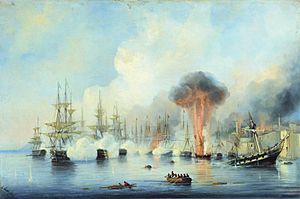
In 1853, Russia destroyed the entire Ottoman fleet at Sinop. Britain and France decided they had to intervene to stop Russia from expanding too much. Even though Ottomans and Russians were fighting, the main reason for the Crimean War was the rivalry between Britain and Russia. The war ended badly for Russia, with the peace treaty of 1856.
These wars lowered Ottoman morale and showed that modern technology and better weapons were crucial for a modern army. The Ottoman Empire was seriously lacking in these areas. Fighting alongside the British, French, and others during the Crimean War, the Ottomans saw how far behind they had fallen. Things started to change after the Crimean War.
Europeans began to see business opportunities in the Ottoman Empire, and more money came in through trade. The government also received more money from a fair tax system with less corruption. The Sultan gained more control over local leaders and increased the taxes they had to pay. However, Sultan Abdülaziz spent much of this money building grand palaces, trying to compete with those in England and France. The Empire was undergoing big changes, and a new sense of Ottoman nationalism was growing. It seemed like the Empire might be able to stop its decline.

However, financial problems and a new threat from Russia led to the final stages of the Empire's collapse. The Crimean War had forced Russia to give up its goal of taking the Ottoman capital of Constantinople and controlling the Bosphorus Strait. Instead, Russia focused on gaining power in the Balkans. Many people in the Balkans were Slavs, like the Russians. They also mostly followed the Eastern Orthodox Church, like the Russians. When new ideas from Russia, like Slavophiles (who supported Slavic unity), spread to the area, it became restless and prone to revolution. When the Ottoman government tried to fix its economic problems, it sparked a revolt in Herzegovina in 1875. This revolt quickly spread to Bosnia and then Bulgaria. Soon, Serbian armies also joined the war against the Turks. These revolts were the first real test for the new Ottoman armies. Even though they weren't as good as Western European armies, they fought effectively but brutally. During the war, the Ottomans carried out the Batak massacre in 1876. A journalist reported that around 5,000 people were killed in Batak alone. Overall, about 15,000 people were killed during the April Uprising.
The Balkan rebellions began to weaken. In Europe, newspapers were full of stories about Ottoman soldiers killing thousands of Slavs. In Great Britain, William Ewart Gladstone wrote about the Ottoman atrocities. Soon, a new Russo-Turkish war began. Even though the Ottoman armies fought better than before, they were still no match for the Russian forces. This time, there was no help from other countries. In fact, many European nations supported Russia, as long as the war didn't get too close to Istanbul. Ten and a half months later, when the war ended, the time of Ottoman control over the Balkans was over. In the Balkans, the Russian army crossed the Danube and captured the Shipka Pass. The Turkish army, after a tough fight, surrendered at Plevna. After that, the Russian army crossed the Balkan Mountains, defeated the remaining Turkish troops, and reached the outskirts of Constantinople. In the Caucasus, the Turkish army held back the Russian attack for a while. But after a defeat at Aladzha, they retreated to Erzurum, and the Russians took Kars. On the Black Sea, the Ottoman fleet had a huge advantage because the Russian fleet hadn't recovered after the Crimean War. Despite this, the fighting on the Black Sea wasn't very important in this war.
Because Russia was so close to the straits, the British intervened in the war, against the Sultan's wishes. A large British naval force entered the Sea of Marmara and anchored where both the royal palace and the Russian army could see them. The British might have saved the Ottoman Empire again, but it ended the good relations between the two powers that had lasted since the Crimean War. Facing the possibility of Britain joining the war, the Russians decided to settle the conflict. The Treaty of San Stefano gave Romania and Montenegro their independence. Serbia and Russia each received more territory. Austria gained control over Bosnia, and Bulgaria was given almost complete self-rule. The Sultan hoped that other major powers would oppose such a one-sided agreement and that a conference would be held to change it. His hope came true. In 1878, the Congress of Berlin was held, where Germany promised to be a "fair mediator." In the new treaty, Bulgarian territory was reduced, and war payments were canceled. The conference also hurt British-Ottoman relations again by giving the British the island of Cyprus. While annoyed at British Prime Minister Benjamin Disraeli, the Sultan praised Otto von Bismarck, who forced many of the major concessions on Russia. These close German-Ottoman relations would continue until both empires ended.
In this century, Russia's expansion focused on supporting the independence of former Ottoman provinces. It also aimed to bring all Slavic peoples in the Balkans under Bulgaria or use Armenians in the east. By the end of the century, from Russia's point of view, Romania, Serbia, and Montenegro had gained independence, and Bulgaria had gained self-rule. This worried the other major powers. After the Congress of Berlin, Russia's expansion was controlled by limiting Bulgaria's growth. The Russian public felt that thousands of Russian soldiers had died for nothing at the end of the Congress of Berlin.
The Balkans
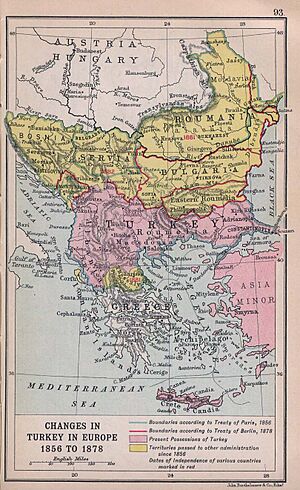
There were two main movements for independence in the western part of the Ottoman Empire. The first happened while the Ottomans were dealing with the Greek uprising, known as the Greek War of Independence. This war led to Russian forces advancing into Bulgaria before the Turks asked for peace. The resulting Treaty of Adrianople on September 14, 1829, gave Russia most of the eastern shore of the Black Sea and the mouth of the Danube River.
The second independence movement occurred during later uprisings. An uprising against Ottoman rule began in Herzegovina in July 1875. The Bulgarians organized the April Uprising, which lasted from April to May 1876.
Serbia gained self-rule, and Russia was allowed to occupy Moldavia and Wallachia (guaranteeing their well-being and full "freedom of trade") until Turkey paid a large sum of money. These uprisings created an opportunity for Russia and Austria-Hungary. They made a secret agreement in July 1877 to divide the Balkan peninsula depending on the war's outcome.
During the Russo-Turkish war of 1877–1878, in February 1878, the Russian army almost reached the Ottoman capital, Istanbul. But fearing the city might fall, the British sent a fleet of warships to stop Russia from entering. Under pressure from the British fleet to negotiate, Russia agreed to a settlement under the Treaty of San Stefano on March 3. By this treaty, the Ottoman Empire recognized the independence of its former provinces: Romania, Serbia, and Montenegro, and the self-rule of Bulgaria. The Congress of Berlin also allowed Austria to occupy Bosnia and Herzegovina and Great Britain to take over Cyprus.
The Caucasus
During the Greek uprising, the Russian empire reached the Ottoman borders in the Caucasus region, which were in the southwest of the region and northeastern Anatolia. Under the Treaty of Adrianople, the Ottoman Empire recognized Russia's rule over western Georgia, which had been under Ottoman control. It also recognized Russia's control over present-day Armenia, which the Russians had conquered a year earlier (1828) from Persia. After the war of 1877-78, Russia also gained the cities of Kars and Ardahan.
End of Empires (1914–23)
In the early months of World War I, Kars was a very important military target for the Ottoman army. Ismail Enver, who pushed the Ottoman Empire into World War I, needed a victory against the Russians to keep his position. He gathered an army on the eastern border. This army was badly defeated under Enver's command at the Battle of Sarikamish on January 2, 1915. This defeat was mostly due to the harsh winter weather and bad planning. With the loss of this eastern army, Ottoman defenses collapsed. The Russian army advanced as far west as Erzincan. The Ottoman army suffered another heavy defeat in the Battle of Erzurum in 1916. After this, the Russian army captured all of Western Armenia. After the 1916 campaign, the front lines remained stable until the Russian Revolution in 1917.
The Russian army fell apart after the 1917 revolution. Only a few Armenian units were left to resist the Ottoman counter-attack. Before World War I ended in 1918, the Ottoman army regrouped and tried to form a defense line on their eastern border. The newly declared First Republic of Armenia captured Kars in April 1918, but it was later given back by the future Soviet government. That same year in March, the Baku Commune was set up in Azerbaijan. This commune later became the Centrocaspian Dictatorship, which was then conquered by the Islamic Army of the Caucasus, then briefly by the Triple Entente, and finally by the Bolsheviks. Defeats on other war fronts forced the Ottoman Empire to surrender and pull back its forces. Both the Armenian and Azerbaijani Republics eventually became part of the Soviet Union in 1920. The border between the Soviet Union and Turkey was set by the Treaty of Moscow (1921).
List of Conflicts
| Name | Date | Result | |
|---|---|---|---|
| 1 | First Russo-Turkish War | 1568–1570 | Russia won |
| 2 | Second Russo-Turkish War | 1676–1681 | Outcome debated Treaty of Bakhchisarai |
| 3 | Third Russo-Turkish War | 1686–1700 | Austria, Poland-Lithuania, Russia, and Venice won Russia gained Azov and other forts |
| 4 | Fourth Russo-Turkish War | 1710–1711 | Ottoman Empire won Russia gave Azov back to the Ottomans |
| 5 | Fifth Russo-Turkish War | 1735–1739 |
Treaty of Belgrade: Austria gave land back to Ottomans |
| 6 | Sixth Russo-Turkish War | 1768–1774 | Russia won Treaty of Küçük Kaynarca: Ottoman Empire gave land to Russia; Crimean Khanate became a Russian client state |
| 7 | Seventh Russo-Turkish War | 1787–1792 | Russia won Treaty of Jassy: Russia took Ozi; Ottomans recognized Russia's control of Crimea |
| 8 | Eighth Russo-Turkish War | 1806–1812 | Russia won Treaty of Bucharest (1812): Russia took Bessarabia |
| 9 | Ninth Russo-Turkish War | 1828–1829 | Russia won Treaty of Adrianople (1829): Russia occupied Danubian Principalities; Greece became independent |
| 10 | Crimean War | 1853–1856 | Ottoman Empire, Britain, France, and Piedmont won Treaty of Paris (1856): Black Sea became neutral; Russia gave up Southern Bessarabia |
| 11 | Tenth Russo-Turkish War | 1877–1878 | Russia and allies won Romania, Serbia, and Montenegro became independent; Bulgaria gained self-rule Russia gained Kars and Batum |
| 12 | World War I:
|
1914–1918 | Germany, Austria-Hungary, and Ottoman Empire won Treaty of Brest-Litovsk Treaty of Kars: Russia gave back territory gained in 1878 to the Ottoman Empire |
See also
 In Spanish: Guerras ruso-turcas para niños
In Spanish: Guerras ruso-turcas para niños
- Ottoman wars in Europe
- Battle of Sarikamish
- Caucasian War
- Crimean Khanate
- Crimean–Nogai slave raids in Eastern Europe
- Foreign policy of the Russian Empire
- List of Serbian–Ottoman conflicts
- Russia–Turkey relations
- Russian conquest of the Caucasus
- Russo-Crimean Wars
- Russo-Persian Wars


